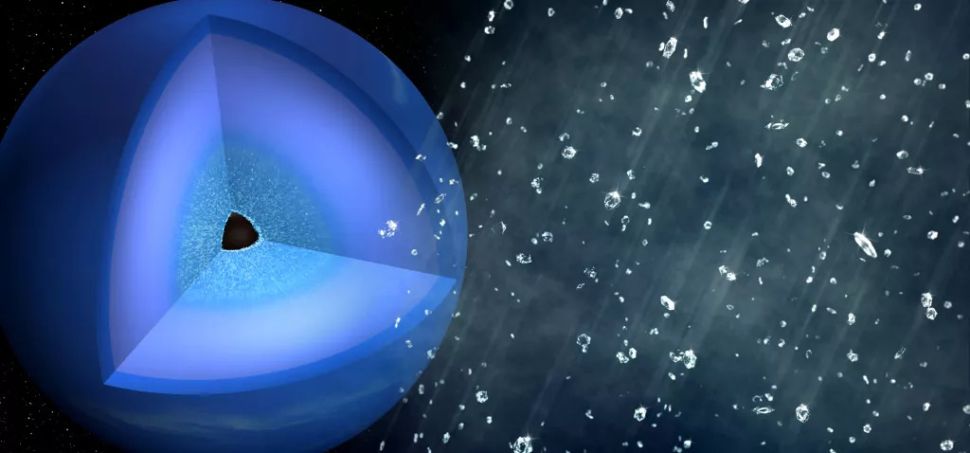Neptune and Uranus are called the “ice giants“ of our Solar System because 80 percent or more of their mass is made up of water, ammonia and methane–compounds known as “ices” in the field of astronomy.
Unlike Earth, these two planets do not have a solid surface. Instead, they have atmospheres mainly composed of hydrogen and helium, and small amounts of methane that gradually merge with a superhot and superdense fluid of icy materials that cover a small, rocky core.
Uranus and Neptune are interesting worlds to study, but current knowledge about these planets is relatively scant because of their distance from Earth– these icy giants lie in the outermost parts of the Solar System.
Voyager 2, to date, is the only space mission that has gathered data from Uranus and Neptune, but mathematical modeling and laboratory experiments suggest that the chemical make-up of these worlds enable the formation of so-called diamond rains.
How Diamond Rains Form
Heat and pressure intensify deeper into these two planets. Simulations reveal that the high temperature and pressure can break down the molecules of methane, a form of hydrocarbon, which isolates the carbon atoms from hydrogen.
Scientists found that the isolated carbon atoms could link together and the resulting chains get squeezed into a diamond structure. The crystalline formations would then drop deeper like diamond rains through the mantle and vaporize when they become too hot.
In a 2017 study published in the Nature Astronomy, Dominik Kraus, from the research laboratory Helmholtz Zentrum Dresden-Rossendorf, and colleagues used the SLAC National Accelerator Laboratory’s Linac Coherent Light Source (LCLS) X-ray laser to demonstrate how methane can be broken down into diamonds.
The researchers recreated the chemical processes that happen inside Neptune and Uranus by creating shockwaves in polystyrene, a kind of plastic made up of carbon and hydrogen, to generate intense heat. The material served as a substitute for the planetary methane on Neptune and Uranus. The simulation revealed that diamonds form at temperatures and pressure that resemble the conditions in the inner parts of the two planets.
“From the surface towards the core, the isentropes of Uranus and Neptune intersect a temperature–pressure regime in which methane first transforms into a mixture of hydrocarbon polymers, whereas, in deeper layers, a phase separation into diamond and hydrogen may be possible,” the researchers wrote in their study.
“Here we show experimental evidence for this phase separation process obtained by in situ X-ray diffraction from polystyrene (C8H8) n samples dynamically compressed to conditions around 150 GPa and 5,000 K; these conditions resemble the environment around 10,000 km below the surfaces of Neptune and Uranus.”
In a follow-up study published in Nature Communications in 2020, Kraus and colleagues used a new technique known as X-ray Thomson scattering to measure how chemical elements behave and mix deep below the icy giants.
The researchers were able to observe how hydrogen and carbon atoms separate in response to intense pressure and temperature that simulate the environment in the inner parts of Uranus and Neptune.
“Here they see how two elements separate, like getting mayonnaise to separate back into oil and vinegar,” said LCLS Director Mike Dunne.
Advancing Research on Fusion Power
Studies on the diamond rain phenomenon occurring in Neptune and Uranus offer insights on the inner workings of planets in the Solar System. Besides this, they may also lead to practical applications on Earth.
The researchers said that they may also help improve experiments that explore the generation of energy from nuclear fusion. Nuclear fusion is a high-energy process that fuels the stars, including the sun. It happens when the nuclei of small atoms combine to form one or more heavier nuclei, releasing massive amounts of energy in the process.
Some fusion experiments involve a fuel of two different forms of hydrogen surrounded plastic that gets blasted with lasers to reach conditions similar to the interior of planets.
“It’s a new way to study the evolutionary history of planets and planetary systems, as well as supporting experiments towards potential future forms of energy from fusion,” Kraus said.
Researchers have been studying the process hoping that it could eventually be harnessed to provide a sustainable source of power on Earth. Unfortunately, fusion power remains elusive, but the findings and methodologies used in studies investigating diamond rains on Uranus and Neptune could lead to the advancement of research on fusion energy.
The X-ray Thomson scattering technique, which enables researchers to study how elements mix in non-crystal samples at extreme conditions, for instance, may shed light on some issues that hamper the development of fusion power.
“This research provides data on a phenomenon that is very difficult to model computationally: the ‘miscibility’ of two elements, or how they combine when mixed,” Dunne commented.
“What they learn could offer insight into a key way fusion fails, in which the inert shell of a capsule mixes in with the fusion fuel and contaminates it so that it doesn’t burn.”
The researchers hope that the technique will allow them to measure the microscopic mix of materials used in fusion experiments.
“We want to understand if this process could occur in inertial confinement fusion implosions with plastic ablator capsules, as it would generate fluctuations that could grow and degrade the implosion performance,” said study researcher Tilo Doeppner, a physicist at the Lawrence Livermore National Laboratory (LLNL).
Researchers are conducting studies to find out how to feasibly control nuclear fusion. If that happens, the reactions can provide an endless supply of energy without the planet-warming greenhouse gas emissions that can exacerbate climate change.





